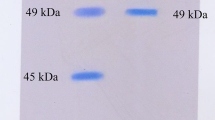Abstract
The compound 2-mercaptoacetyl-l-phenylalanyl-l-leucine (HSAc-Phe-Leu) is a specific and potent inhibitor ofPseudomonas aeruginosa elastase with demonstrated potential as a drug for the treatment ofPseudomonas eye infections. The thiol moiety of this compound is lost in the presence of the bacterial at a rate greater than that seen in the absence of the organisms. Tritium-labeled inhibitor was prepared and used to examine whether this accelerated loss is due to the uptake of the inhibitor by the bacteria or due to its modification by some bacterial products. Our results excluded by possibility of uptake and indicated that the loss of the thiol resulted from its oxidation to the inactive disulfide form. The oxidation reaction is probably catalyzed by a low molecular weight extracellular bacterial product, and is effectively prevented in the presence of sodium bisulfite. It is suggested that HSAc-Phe-Leu preparations used for further investigation of the inhibitor's therapeutic potential should include antoxidants such as sodium bisulfite to provide maximal inhibitory capacity.
Similar content being viewed by others
Literature Cited
Blumberg S, Tauber Z (1983) Inhibition of metalloendopeptidases by 2-mercaptoacetyl dipeptides. Eur J Biochem 136:151–154
Ellman GL (1959) Tissue sulfhydryl groups. Arch Biochem Biophys 82:70–77
Holder IA, Haidaris CG (1979) Experimental studies of the pathogenesis of infections due toPseudomonas aeruginosa: extracellular protease and elastase as in vivo virulence factors. Can J Microbiol 25:593–599
Kawaharajo K, Abe C, Homma JY, Kawano M, Gotoh E, Tanaka N, Morihara K (1974) Corneal ulcers caused by protease and elastase fromPseudomonas aeruginosa. Jpn J Exp Med 44:435–442
Kessler E, Kennah HE, Brown SI (1977)Pseudomonas protease: purification, partial characterization and its effect on collagen, proteoglycans and rabbit corneas. Invest Ophthalmol Vis Sci 16:488–497
Kessler E, Israel M, Landshman N, Chechick A, Blumberg S (1982) In vitro inhibition ofPseudomonas aeruginosa elastase by metal-chelating peptide derivatives. Infect Immun 38:716–723
Kessler E, Safrin M (1982) Growth ofPseudomonas aeruginosa and secretion of protease in the presence of the protease inhibitors. Metab Pediatr Syst Ophthalmol 6:331–336
Kessler E, Spierer A, Blumberg S (1983) Specific inhibition ofPseudomonas aeruginosa elastase injected intracorneally in rabbit eyes. Invest Ophthalmol Vis Sci 24:1093–1097
Kreger AS, Gray LD (1978) Purification ofPseudomonas aeruginosa proteases and microscopic characterization of pseudomonal protease induced rabbit corneal damage. Infect Immun 19:630–648
Pavlovskis OR, Wretlind B (1979) Assessment of protease (elastase) as aPseudomonas aeruginosa virulence factor in experimental mouse burn infection. Infect Immun 24:181–187
Schröder E, Lübke K (1965) Carboxyl-protecting groups. In: The peptides, vol 1. New York: Academic Press, pp 52–64
Spierer A, Kessler E (1984) The effect of 2-mercaptoacetyl-l-phenylalanyl-l-leucine, a specific inhibitor ofPseudomonas aeruginosa elastase, on experimentalPseudomonas keratitis in rabbit eyes. Curr Eye Res 3:645–649
Woods DE, Cryz SJ, Friedman RL, Iglewski BH (1982) Contribution of toxin A and elastase to virulence ofPseudomonas aeruginosa in chronic lung infections of rats. Infect Immun 36:1223–1228
Author information
Authors and Affiliations
Rights and permissions
About this article
Cite this article
Kessler, E., Safrin, M. & Levin, Y. Oxidation of 2-mercaptoacetyl-phenylalanyl-leucine, a specific inhibitor ofPseudomonas aeruginosa elastase, in the presence of the bacteria and its prevention. Current Microbiology 12, 307–310 (1985). https://doi.org/10.1007/BF01567887
Issue Date:
DOI: https://doi.org/10.1007/BF01567887




